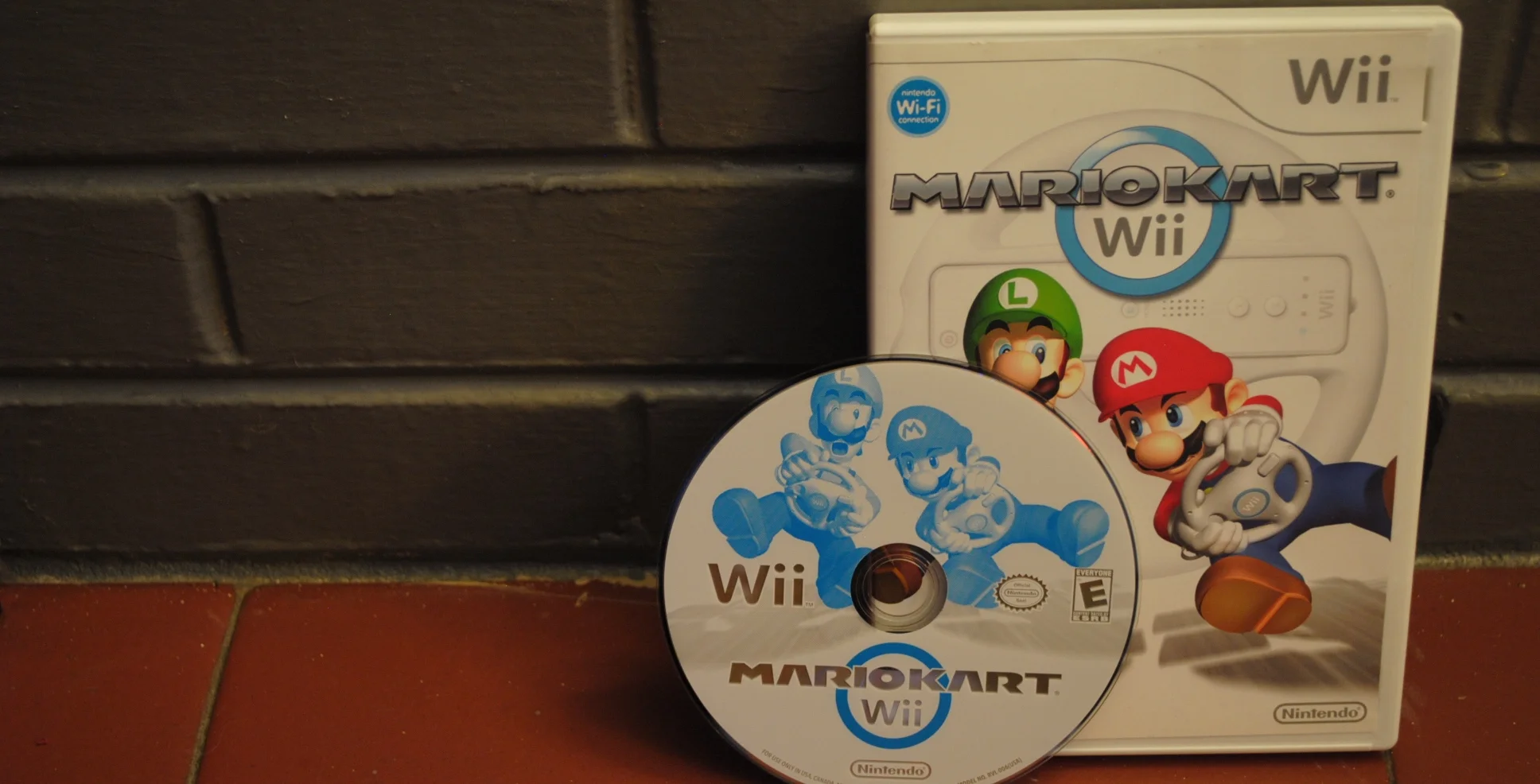This is a big one.
Mario Kart Wii debuted on Nintendo's wildly popular Wii console in 2008 and went on to become the best-selling racing game of all-time and the fifth best-selling game. Ever.
Many critics decried Mario Kart Wii's balance issues, wider tracks, simplification of power-sliding, and more diplomatic approach to Battle Mode, but none of that even slowed the game down for a second. Despite agreeing with a few of those grumbles, I have had countless hours of fun with friends and family playing this game, so it easily lives up to the hype in my book.
But let's back up a minute. If you haven't been following, this is part six of a seven-part series leading up to Mario Kart 8 on May 30. In it, I'm revisiting each of the main Mario Kart games and sharing some memories, impressions and other fun content celebrating this unique and groundbreaking series. Catch up on the SNES' Super Mario Kart, the N64's Mario Kart 64, the GBA's Mario Kart Super Circuit, the GameCube's Mario Kart Double Dash!!, the Nintendo DS' Mario Kart DS, and then head back here to keep reading!
Mario Kart Wii introduced a number of new features: it was the first home console Kart with online play, it added bikes to the mix, Miis became playable characters, and we got motion control with the near-universally-hated Wii Wheel accessory.
Even thought Mario Kart DS had online play, it wasn't quite as exciting as having a really solid online system for a home console Mario Kart game. Because the Wii and this game, specifically, were so widespread, it was possible to play with friends all over the globe. The lack of voice chat was unfortunate, but I remember loading up a Google video chat while playing with our friends in Paris. That was a pretty awesome experience.
The Wii console had a really cool "channel" interface for the main menu that often went underutilized--nothing more than a series of arrangeable icons for downloadable games and a few built-in channels. For Mario Kart Wii, though, Nintendo got creative and included the ability to install a special Mario Kart Channel to their console. This accomplished a few things: it provided a way for players to keep Mario Kart Wii in mind even when the disc wasn't in the system, it allowed racers to check on leaderboard scores without the disc, and it provided a way for Nintendo to distribute special racing challenges. The challenges were a unique addition that let Nintendo's developers play around with existing tracks and environment objects to create new objectives in otherwise familiar settings. My fascination with it faded over time, but it was a cool way to keep players engaged with the game even when they didn't have a bunch of friends around for a few laps.
Really, though, the true magic of any Mario Kart game lies in its local multiplayer--that is, friends sitting in the same room around the same console. As the first 16:9 widescreen Kart game, that actually made a huge difference for me because it meant that a four-player splitscreen match suddenly had much larger quadrants for each player. Playing on a 20" 4:3 CRT vs. a 32" 16:9 HDTV (or, later, a 50" HDTV) made a huge difference in the multiplayer experience.
In terms of tracks, Mario Kart Wii continued the tradition started in Mario Kart DS of including 16 new courses and 16 retro courses for a total of 32 courses. The retro courses looked great, but it was really the new courses that felt truly exciting to me. Tracks like Coconut Mall, Maple Treeway, and Wario's Gold Mine all introduced unique settings that were fresh and new. Others, like Mushroom Gorge, with its bouncing mushrooms, or Grumble Volcano, with its progressive track deformation, actually introduced new types of obstacles that are still fun to this day.
While karts returned (really, they kind of had to, lest the game's title had been changed), bikes were a new addition to the series. From my experience, they were a bit of a love-it-or-hate-it vehicle. They went faster but handled worse. For me, as someone who typically plays as Toad for the handling, they weren't an ideal option; for others, they were awesome. The good news was that they were simply an option, so it's hard to complain about getting more, especially when they were implemented so nicely with the rest of the package.
When this game released, a lot of critics pegged it for having a lower graphical fidelity than other first-party Nintendo titles of the era. Personally, I always enjoyed the softer, rounder art style that Nintendo utilized in Mario Kart Wii. It has almost a fairy-tale feel to it, which is unusual for the series, but I thought it really worked on courses like Maple Treeway. It just seemed whimsical and stood on its own from the other Mario games on the console.
Also, it's unfair to compare a racing game designed for multiplayer to something like Super Mario Galaxy. The Wii was a notoriously underpowered system for its time, so there was an inherent limit to what could be done. Nintendo did a nice job of optimizing the courses for single-player while making them perfectly playable and attractive in multiplayer. indeed, the game feels nicely balanced, in a graphical sense, regardless of whether you're playing with one, two, three or even four players. And, while four player racing means less details on the course, the gameplay never takes a hit.
As the Wii introduced a new way to control games with the motion-sensing Wii Remote, it followed suit that its flagship racer would allow for motion-controlled steering. In fact, the game launched with the Wii Wheel, a plastic shell for your Wii Remote that turned it into a floating steering wheel. This, like many Wii concepts, made for a fantastic sizzle reel during E3 press conferences, but turned out to be a pretty awkward way to control the game. In fact, the Wii Wheel was truly just a shell--the game controlled the exact same way if you just held the remote sideways.
Either way, though, controlling a kart or bike this way was simply not very fun; any racing game worth its salt is about precision steering, and tilting a floating object really didn't cut it. Logically, it's even a flawed idea: a steering wheel is designed to be anchored to a steering column with resistance as you turn it. Proper racing wheels, like the one Microsoft released for the Xbox 360, went to great lengths to replicate this. Nintendo's solution was cute and cheap, but it was very little fun for anyone serious about their karting.
It seems that Nintendo's development realized this, too, and actually made a meta game around the difficulty of using the Wii Wheel, offering special badges by leaderboard scores for any lap/race times achieved using the Wii Wheel. I can only assume Nintendo's marketing department forced them to use the imperfect input method and this was their way of at least putting some of that classic Nintendo charm around what might otherwise feel like a gimmick with no redeeming value.
Luckily, though, Nintendo offered a ton of other ways to play the game: Wii Remote + Nunchuk (my favorite), Classic Controller (my wife's favorite), or a GameCube controller. Even better, though, the game let you mix and match any of these options. This same approach would be mimicked in a number of other Wii titles, including the also-mega-popular Smash Bros. Brawl. Getting that level of customization felt Nintendo was anticipating its fans' desires, and it was a success for everyone.
It's impossible to separate Mario Kart Wii from the timing of its release in my life: this was the first home console Kart game to debut after I had reached the legal drinking age. Party games were fun in high school, but partying while playing party games was an entirely new and pretty awesome experience. To this day, one of my top two favorite drinking games is "Drinking Mario Kart" (it shares that honor with "Sink the Biz," a legendary drinking game from Indiana University's Nick's English Hut).
The rules of the game are simple (for 21+ racers only!):
- Gather four players and boot up a Mario Kart game (N64, GameCube or Wii)
- Distribute beer to each player (other drinks work but don't go too strong)
- Begin racing. During each race:
- Whoever is in first place and, therefore, crosses the finish line first on each lap must PAUSE the game immediately.
- Everyone should take one sip of their drink to match their current standing (i.e., first place drinks one sip, second place drinks two sips, and so on).
- When all drinking has completed, racing should resume.
- Continue this process until the end of the race. At the end of the race, though, all sip counts should be doubled.
- Because skill levels can vary, it is recommended to alternate the sipping rules every other race. So, for your next race, first place should drink four sips, second place should drink three sips, and so on.
- That's the game. You will have fun.
I recommend turning off the computer racers for this game if you are playing Mario Kart Wii, as it can be difficult to determine your ranking when everyone is scattered among a total of twelve racers and you only care about the four human racers. Also, Mario Kart Wii, rather annoyingly, turns off the 1st/2nd/3rd/4th place markers whenever you pause it, so you may need to quickly un-pause and re-pause the game to remember your place if you are using this version (especially as the night goes on and everyone gets a little less clear-headed).
While I still need to cover Mario Kart 7, this is the last home console game to cover before Mario Kart 8. It's served me well over the last six years as the premiere kart racing/party game solution. I look forward to its upcoming big brother, but I am a little bittersweet about retiring it. In fact, though, the game has already started its retirement, with Nintendo recently shutting down its online servers for games like Mario Kart Wii.
The living room multiplayer will, of course, live on!

